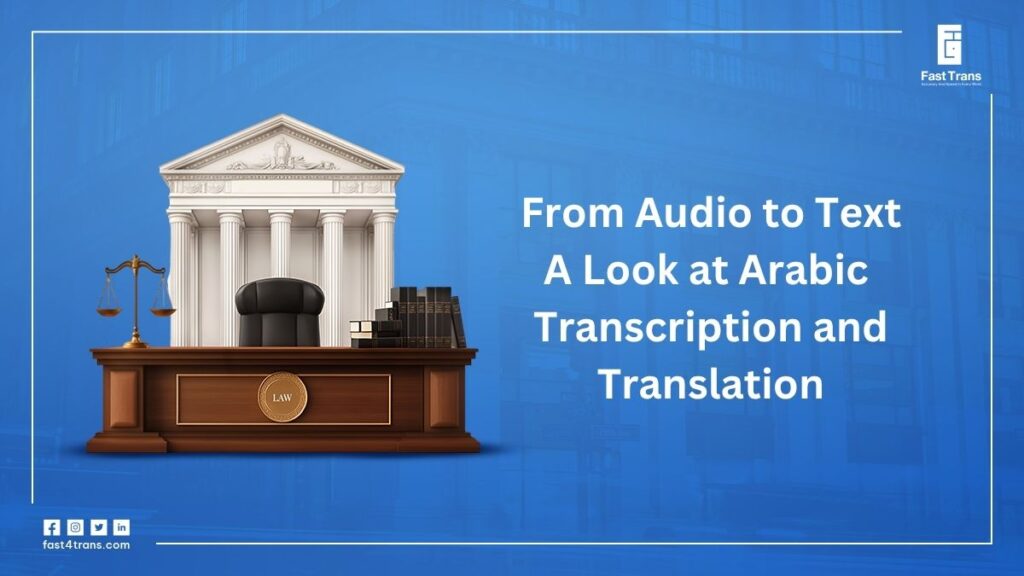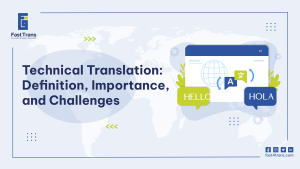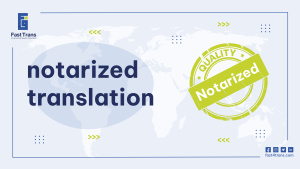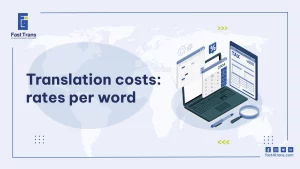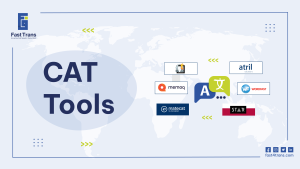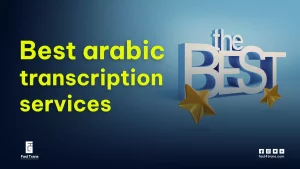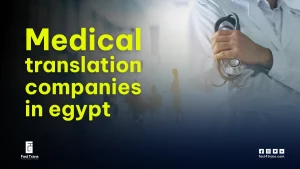In today’s interconnected world, the ability to capture spoken words and render them into written text, or translate them into another language, has become essential. Transcription and translation bridge the gap between spoken communication and wider accessibility, enabling accurate records in fields such as media, business, law, and education.
Whether it’s a podcast that needs subtitles, a courtroom session that requires a written record, or an academic lecture that must be accessible across languages, transcription and translation ensure that spoken content reaches a broader audience.
When it comes to Arabic, the demand is particularly strong. With over 400 million speakers worldwide and Arabic being one of the six official languages of the United Nations, the need for precise transcription and translation continues to grow. Global communication in business, international law, digital media, and cross-cultural exchange increasingly relies on high-quality Arabic transcription to ensure clarity, inclusivity, and compliance. This rising demand makes Arabic a language of focus for both human linguists and advanced AI-powered transcription tools.
What is Transcription vs. Translation?
Although the terms are sometimes used interchangeably, transcription and translation serve very different purposes.
Transcription is the process of converting spoken language into written text. In other words, it is about capturing exactly what is said in an audio or video recording and turning it into a readable format. For example, a journalist may transcribe an interview to analyze it later, or a legal proceeding may require a verbatim transcript for official records.
Translation, on the other hand, goes a step further. It involves taking text written in one language and accurately rendering it into another, while preserving meaning, tone, and context. Translation is not just about replacing words; it requires cultural understanding, especially in Arabic, where idioms, expressions, and context can dramatically change interpretation.
The Uniqueness of the Arabic Language
Arabic stands out as one of the most diverse and complex languages in the world, making transcription and translation particularly challenging.
One of the biggest factors is the variety of dialects spoken across the Arab world. While Modern Standard Arabic (MSA) is used in formal settings such as media, education, and official documents, everyday communication often takes place in dialects like Egyptian, Gulf, Levantine, or Maghrebi Arabic.
Arabic Transcription: Challenges and Techniques
Transcribing Arabic audio into text is far from straightforward. The language’s diversity and usage in different contexts introduce unique challenges that require both skill and the right tools. Here are five key factors to consider:
1. Dialectal Variations
Arabic is not a single spoken form but a collection of dialects, each with distinct vocabulary and pronunciation. For example, the word for “car” could be sayyara in MSA, but Egyptians might say ‘arabeya. A transcriber must be able to recognize and adapt to these differences to produce accurate text.
2. Code-Switching with Other Languages
In many regions, speakers frequently switch between Arabic and other languages such as English or French. This “code-switching” is common in business, media, and daily conversation, especially in North Africa and the Gulf. Transcribers need to capture these shifts precisely without losing meaning.
3. Accents and Regional Pronunciation
Even within a single dialect, pronunciation can vary based on region, social background, or education level. For instance, the letter ج is pronounced as /g/ in Egypt but /ʒ/ in the Levant. Accurate transcription requires sensitivity to these subtle differences.
4. Background Noise and Audio Quality
Many transcription tasks come from recordings of meetings, interviews, or media broadcasts, where background noise and overlapping speech make it difficult to capture every word. Human transcribers often outperform machines in these scenarios by relying on context and experience.
5. Human vs. Automated Tools
Automated transcription tools powered by AI and speech recognition are improving, but Arabic still poses significant challenges due to its dialects and complex script. While machines can handle clear, formal MSA with increasing accuracy, human expertise remains critical for nuanced or dialect-heavy recordings. Often, the most reliable approach is a hybrid model where AI provides a draft and human transcribers refine it.
Key Considerations Regarding Arabic Translation:
Translating Arabic is not simply about converting words from one language to another; it involves navigating cultural, contextual, and legal dimensions that make accuracy and sensitivity crucial.
1. Literal vs. Contextual Translation
A literal, word-for-word translation may capture the vocabulary but lose the intended meaning, especially in Arabic, where idioms and expressions are deeply rooted in culture. For example, the phrase “يد واحدة لا تصفق” (literally “one hand cannot clap”) would make little sense if translated directly into English.
A contextual translation, “teamwork is essential,” captures the true meaning. Skilled translators must strike a balance between fidelity to the original text and clarity in the target language.
2. Cultural Adaptation (Localization)
Beyond language, effective translation often requires localization, adapting content to suit cultural norms and audience expectations. This is particularly important in fields like marketing, media, and education.
A slogan that resonates in one Arab country may not have the same impact, or could even be misunderstood, in another due to dialectal differences or cultural sensitivities. Localization ensures that the translated message feels natural and relevant to its audience.
3. Certified/Legal Translation vs. Standard Translation
In official contexts such as immigration, court cases, or government documentation, a certified or sworn translation is required. This type of translation is legally recognized and guarantees accuracy and authenticity.
On the other hand, standard translation is more flexible and commonly used for business, academic, or personal purposes where legal recognition is not necessary. Understanding the distinction between the two is essential, as using the wrong type of translation can delay processes or lead to miscommunication.
Technology in Arabic Transcription & Translation
Advances in artificial intelligence have transformed the way transcription and translation are performed, offering faster and more scalable solutions. Yet, when it comes to Arabic, technology still faces unique hurdles due to the language’s complexity and diversity.
1. AI-Powered Speech Recognition (ASR) for Arabic
Automatic Speech Recognition (ASR) systems have become increasingly capable of converting spoken Arabic into text. These tools are widely used in customer service (voice assistants, call centers), media, and education.
However, ASR struggles with dialectal differences, overlapping conversations, and background noise. Most systems perform best with Modern Standard Arabic (MSA), but accuracy decreases significantly with regional dialects.
2. Machine Translation (MT) Progress and Limits for Arabic
Machine Translation tools such as Google Translate and DeepL have improved greatly in recent years, offering instant translation between Arabic and dozens of languages.
They are useful for quick, informal communication or to grasp the general meaning of a text. However, MT often fails to capture cultural nuance, idiomatic expressions, or context-specific meanings. A literal machine-generated translation may be grammatically correct but contextually misleading.
3. Hybrid Approaches (Human + AI)
The most effective solutions today combine the efficiency of AI with the accuracy of human expertise. For example, AI can generate a first draft of an Arabic transcription or translation, which a human linguist then reviews and refines. This hybrid model reduces costs and turnaround time while ensuring quality and cultural sensitivity. Many professional services now rely on this blended approach, especially when dealing with industries that demand both speed and precision, such as media, law, and international business.
Read Also: DTP And Why Does it Matter for Arabic Translations
Transcription Applications Across Industries
Arabic transcription plays a vital role across multiple industries, ensuring that spoken content is preserved, accessible, and usable in different contexts. From media to law, its applications are wide-ranging and increasingly in demand.
1. Media & Entertainment
Subtitles, dubbing, and closed captions rely heavily on transcription. Arabic podcasts, TV shows, and news broadcasts often begin with accurate transcripts before translation into other languages.
This ensures accessibility for viewers, including those with hearing impairments, and allows Arabic media to reach international audiences. Streaming platforms like Netflix and YouTube, for instance, depend on transcription as the first step in producing multilingual subtitles.
2. Business & Marketing
In global markets, transcription helps organizations analyze customer interactions, meetings, and interviews conducted in Arabic. These transcripts can then be translated to share insights with international partners.
In marketing, transcribed Arabic content, such as ads, focus group discussions, and social media campaigns, can be localized for broader engagement. Accurate transcription ensures that the original message is preserved while being adaptable for global communication strategies.
3. Legal, Medical, and Academic Fields
In the legal sector, Arabic transcription is essential for documenting court hearings, depositions, and arbitration sessions. In medicine, transcription supports patient records, research interviews, and doctor-patient consultations, ensuring clarity in diagnosis and treatment.
In academia, transcription enables researchers to document Arabic lectures, seminars, and interviews, often serving as a foundation for translation into other languages for international collaboration. In each of these fields, precision and confidentiality are critical, making high-quality transcription indispensable.
Read Also: Key Benefits of Arabic Professional Translation Services for Your Business
Human Expertise vs. Automation
As technology advances, the balance between human expertise and automation in transcription and translation has become a central discussion. While automation brings efficiency, the human element remains irreplaceable in many scenarios, especially with a language as nuanced as Arabic.
| Aspect | Human Transcribers & Translators | Automated Tools (AI/ASR/MT) |
| Accuracy | High accuracy, especially with dialects, slang, and complex contexts. | Good with clear Modern Standard Arabic, but struggles with dialects, accents, and noisy audio. |
| Cultural Sensitivity | Strong understanding of idioms, humor, and cultural nuances. | Limited cultural awareness often translates literally. |
| Context Handling | Can interpret meaning based on tone, setting, and intent. | Lacks contextual judgment; may produce awkward or misleading phrasing. |
| Speed | Slower, especially for large volumes of content. | Very fast; can process hours of audio or thousands of words in seconds. |
| Cost | Higher, due to the professional expertise required. | Lower cost, especially for bulk or repetitive tasks. |
| Use Cases | Legal, medical, literary, marketing, and diplomatic content where precision is critical. | Large-scale transcription (e.g., lectures, news), quick drafts, informal communication. |
| Best Approach | Ensures quality, accuracy, and cultural fit. | Provides speed and scalability. Often best used in combination with human review. |
Why Choose Fast Trans for Arabic Transcription and Translation?
When it comes to Arabic transcription and translation, accuracy and cultural sensitivity are essential. At Fast Trans, we combine human expertise with advanced technology to deliver reliable and precise results for every project. Our team of professional linguists understands the complexities of Arabic, whether it’s Modern Standard Arabic or regional dialects, ensuring that your message is captured faithfully and clearly.
From transcribing podcasts, interviews, and business meetings to translating legal contracts, medical reports, or marketing campaigns, Fast Trans provides tailored solutions that meet the highest standards of quality. We are committed to confidentiality, fast turnaround times, and maintaining the cultural integrity of your content.
Whether you are a business expanding into Arabic-speaking markets, a law firm requiring certified translations, or a media company seeking accurate transcripts and subtitles, Fast Trans is your trusted partner for bridging language barriers.
Contact us today via our official website
What Our Customers Say
Since the translation project is theirs, we encourage the clients to discuss every stage of the process.
You can check our clients’ comments for yourself at Google Reviews.
Conclusion
Arabic transcription and translation are more than just language services; they are essential tools for communication in today’s globalized world. From ensuring accessibility in media to supporting international business, legal proceedings, and education, they bridge gaps between spoken words and written records, between cultures and industries.
The unique complexities of Arabic, its many dialects, script, and cultural nuances, make precision and sensitivity crucial at every step.
As demand continues to rise, the future of Arabic transcription and translation lies in a hybrid approach that combines the speed of advanced AI with the depth of human expertise.
With trusted providers like Fast Trans, individuals and organizations can rely on solutions that deliver both accuracy and cultural integrity, ensuring that Arabic communication remains clear, professional, and globally understood.

